It takes a village to save the village
When disaster strikes, whether natural or manmade, we rush first to aid the injured, succor the survivors and bury the dead. But once the flood waters recede, the aftershocks quiet and the horrors of war dim, we are faced with other casualties: the damage to and loss of the art, architecture and other aspects of our irreplaceable cultural heritage.
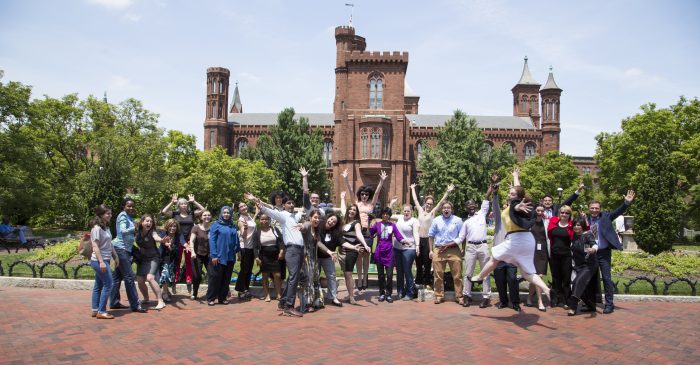
FAC 2016! The International Course on First Aid to Cultural Heritage in Times of Crisis was held for the first time in Washington, D.C., at the Smithsonian in June. Here, FAC participants gather behind the Castle for a group photo before the opening ceremony. (Photo by Michael Barnes)
In June, the Smithsonian hosted First Aid to Cultural Heritage in Times of Crisis. This four-week training program brought 21 participants from 17 different countries to Washington, D.C., for an intensive curriculum developed by the International Centre for the Study of the Preservation and Restoration of Cultural Property (ICCROM) and the Smithsonian. The program’s goal is to help cultural heritage professionals ─ particularly those working in crisis-affected or disaster-prone areas ─ develop disaster response skills.
The Smithsonian, along with its partners, is at the forefront in developing this kind of training after our leadership role in the Haiti Cultural Recovery project conducted in the aftermath of the devastating 2010 Haiti earthquake. To continue and expand our role in helping preserve endangered cultural heritage around the world, the Smithsonian’s Cultural Rescue Initiative partnered with ICCROM to bring the FAC training to the U.S. for the first time.
While the Smithsonian has hosted many individual seminars and training programs in the past related to disaster response, such as object handling, salvaging practices and safety demonstrations, FAC 2016 combines training in best practices across disciplines, with the added intensity of practical application. Of the more than 20 days of instruction in the month-long course, seven were devoted to full-day practical sessions, requiring unprecedented planning and coordination. These sessions provided realistic disaster situations, complete with ruined heritage collections and situational role players who might provide important information to participants or who might obstruct and impede their ability to act.
SCRI was able to rally the Smithsonian’s vast resources to make these practical sessions an invaluable part of the training – venues that could be staged as a disaster zone, expert teachers who could instruct on a variety of topics, and stockpiles of recovery and safety supplies ─ not to mention the meticulous planning and event memos necessary to ensure each practical scenario was executed in perfect timing with the First Aid Course curriculum. Thanks are owed to each and every unit that helped secure classroom space, catering, audio-visual help, and the scarcest of Smithsonian resources ─ storage space.
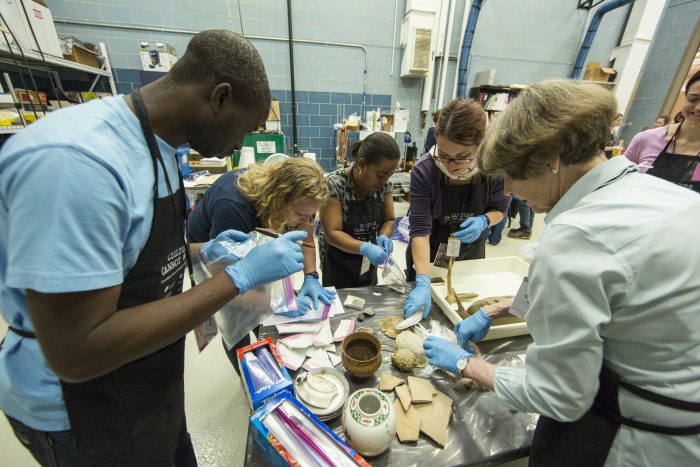
Cathy Hawks of the National Museum of Natural History (right) demonstrates procedures for handling damaged objects. Rebecca Kennedy (second from left) of the National Postal Museum, was one of the Smithsonian staff who participated in FAC 2016. (Photo by Michael Barnes)
Often when the Smithsonian finishes a project of this magnitude, the spotlight is turned on measuring the obvious: number of people trained, the public impact, future projects undertaken or the collections protected. As Project Manager for the FAC 2016 training program, I would like to acknowledge and celebrate the inner mechanisms of the Smithsonian and mention just a few (because the list is much longer) of the “back of house” team that made such an important and complex program possible: Chuck Darby and Pat Smith from Smithsonian Facilities found coveted space on the Quad loading dock; Jessie Johnson at the Museum Conservation Institute rallied conservators from across the Smithsonian for conservation sessions; Dan Davies and Paul Tintle from the Office of Facilities Engineering and Operations and Cheryl Gibney from the Office of Special Events and Protocol walked us through the complex process of using the Arts & Industries Building; Freddie Adelman of Smithsonian Associates, Gil Taylor from Smithsonian Libraries, and Berna Onat and Efrain Tejada from Natural History’s Q?rius Lab loaned us their valuable classroom space; Amy Adams and the staff from the Office of the Provost was our inexhaustible finance and procurement team; Rebecca Wall and Maria Sanchez from the Office of International Relations braved the heat to videotape some of our activities; Kerry Button at the Museum Support Center and Cathy Hawks from Natural History found leftover supplies for us to use on salvage day; Erik Satrum from the Air and Space Museum, and Bill Tompkins and Samantha Snell from the National Collections Program provided deaccessioned objects for demonstrations; Officer Steven Burke and others from the Office of Protection Services manned the doors of A&I and went above and beyond the call of duty in providing assistance; JR Smith from the Office of Safety, Health and Environmental management served as “safety liaison,” reviewing the mountain of event memos and briefing our participants on preventing heat exhaustion.
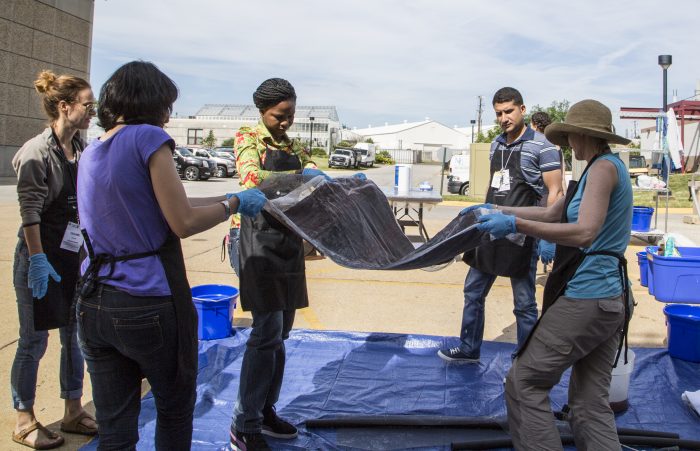
Susan Heald, of the National Museum of the American Indian (far right, in hat), teaches FAC 2016 participants how to properly handle wet and damaged textiles. (Photo by Michael Barnes)
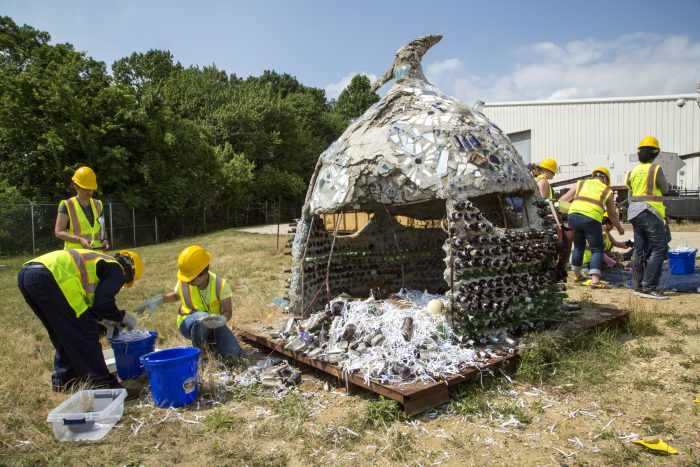
A deaccessioned multi-media structure served as a damaged hypothetical heritage building in another exercise during FAC 2016. Participants needed to assess the damage and put together a plan to salvage the material. (Photo by Michael Barnes)
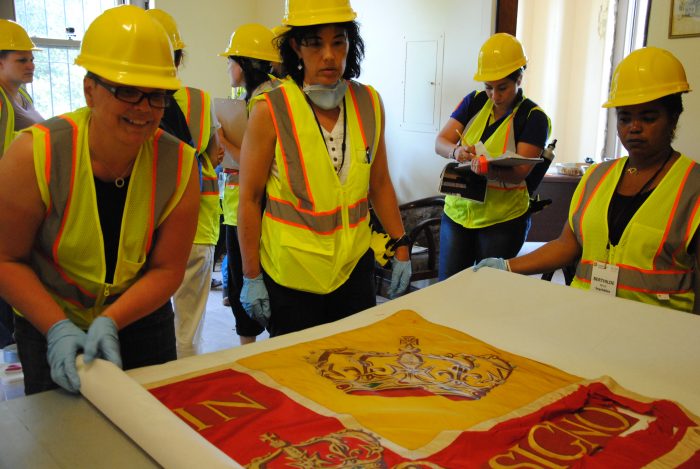
In one practical exercise at the Arts and Industries Building, FAC participants documented, packed and evacuated a staged collection of non-Smithsonian objects. (Photo by Stacy Bowe)
These are just a few of the many people who made this international cooperative effort possible. Of the more than 60 members of our teaching team, 24 were Smithsonian staff from 12 different Smithsonian units or departments. Three freshly-inducted interns were sent from three different units to join the team to handle the day-to-day tasks. Over the course of the four weeks, FAC participants convened in eight different Smithsonian venues ─ sometimes usurping them entirely (thanks for understanding, Luce Center!). Participants were given comprehensive tours of exhibits, conservation labs and collections tours that brought depth to their training.
We all know the boilerplate description of the Smithsonian: The world’s largest research, education and museum complex with 19 museums and galleries, nine research centers and the National Zoo. It’s a bit of a truism that individual units are very independent. The success of FAC 2016 shows just what we can accomplish when we collaborate, cooperate and put together great teams from across units, proving yet again that the Smithsonian is far greater than just the sum of its parts.

Participants gather for a group photo during the final exercise of FAC 2016, which took place at the D.C. Fire and EMS Training Academy in southeast Washington, D.C. (Photo by Maria C. Sanchez)
Posted: 5 August 2016
-
Categories:
Art and Design , Collaboration , Education, Access & Outreach , Feature Stories , History and Culture , Science and Nature



